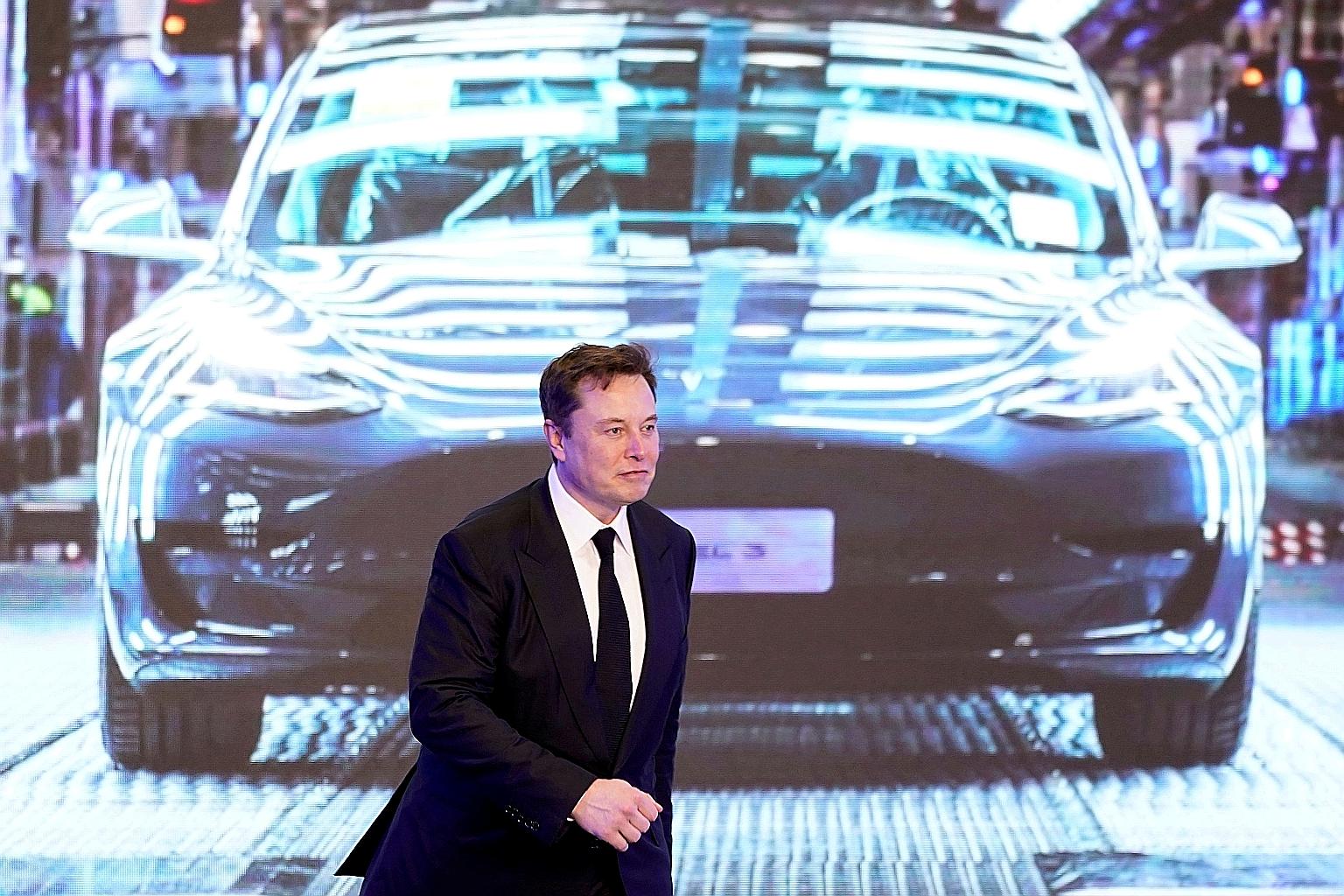Explainer
Why building an electric vehicle is so expensive
Batteries' high cost is main factor; companies now working on use of cheaper materials
Sign up now: Get ST's newsletters delivered to your inbox

Tesla's CEO Elon Musk during the January opening ceremony for his company's China-made Model Y programme in Shanghai. Asia dominates manufacturing of the lithium ion cells used in electric vehicles and other electronic devices, accounting for more than 80 per cent of existing capacity.
PHOTO: REUTERS
Follow topic:
PALO ALTO • At Tesla's ballyhooed Battery Day event in September, chief executive Elon Musk set himself an ambitious target: to produce a US$25,000 (S$33,900) electric car in three years.
Hitting that sticker price - about US$13,000 cheaper than the least expensive model today - is seen as critical in delivering a true, mass-market product.
Getting there means finding new savings on technology, most critically the batteries that can make up one-third of the cost of an electric vehicle (EV).
Q: Why are EV batteries so expensive?
A: Largely because of what goes in them. An EV uses the same rechargeable lithium-ion batteries that are in your laptop or mobile phone, but they are just much bigger to enable them to deliver far more energy.
The priciest component in each cell is the cathode, one of the two electrodes that store and release a charge.
That is because the materials needed in cathodes to pack in more energy are often expensive: metals such as cobalt, nickel, lithium and manganese. They need to be mined, processed and converted into high-purity chemical compounds.
Q: How much are we talking about?
A: At current rates and pack sizes, the average battery cost for a typical electric vehicle works out to about US$7,350.
That has come down a lot - 87 per cent over the past decade, according to BloombergNEF.
But the average pack price of US$156 per kilowatt hour (kWh) - from about US$1,183 in 2010 - is still above the US$100 threshold at which the cost of an EV should match a car with an internal combustion engine.
Q: How will the batteries get cheaper?
A: Lithium ion packs are on track to drop to US$93 per kWh by 2024, according to Bloomberg forecasts.
To get there, one focus for manufacturers is replacing high-cost cobalt with nickel. That has a double benefit: nickel is cheaper and it also holds more energy, allowing manufacturers to reduce the volume needed.
-
US$25k
Tesla chief Elon Musk's ambitious target cost for an electric car, which is about S$33,900.
US$38k
What the least expensive model of electric car costs today.
However, cobalt's advantage is that it does not overheat or catch fire easily, meaning manufacturers need to make safety adjustments when they use a substitute.
Panasonic in Japan plans to commercialise a cobalt-free version of a high-energy battery in two to three years; other suppliers already produce lower-energy ones.
There is also attention on the battery packs, often resembling oversized suitcases, that house rows of individual cells. Simplifying the design, and using a standard product for a range of vehicles - rather than a pack tailored to each model - will deliver additional savings.
Q: Who are the biggest manufacturers?
A: Asia dominates manufacturing of lithium ion cells, accounting for more than 80 per cent of existing capacity. The majority of that might is in China.
Europe is building new factories and will surpass North America in cell manufacturing from next year, according to Wood Mackenzie.
Overall, the Chinese firm Contemporary Amperex Technology shipped the highest volumes last year, including batteries bound for power grids and storage systems.
It is a tighter field in the race to supply automakers, where Panasonic led last year. South Korea's LG Chem has surged ahead this year, capturing about a quarter of the market in the first eight months, according to SNE Research. Tesla and Panasonic's joint venture is the biggest battery producer in the US.
Emerging producers include Northvolt in Sweden, founded by former Tesla executives.
Q: Are all EV batteries the same?
A: Lithium ion technology has dominated the rechargeable-battery sector since it was commercialised by Sony in 1991. Improvements to life-span, power, weight and costs have led to the components' usage leaping from camcorders to SUVs, buses and ferries.
While lithium ion cells, like all batteries, have the same basic components: two electrodes - a cathode and an anode - and an electrolyte that helps shuttle the charge between them, there are differences in the materials used, and that is key to how much energy they hold.
Grid storage systems, or vehicles travelling short distances, can use cheaper and less powerful cathode chemistry that combines lithium, iron and phosphate.
For higher-performance vehicles, carmakers favour more energy-dense materials, such as lithium-nickel-manganese-cobalt oxide or lithium-nickel-cobalt-aluminium oxide.
Q: Is cost the only hurdle?
A: There is still an issue with driving range. While the most expensive EVs can travel 640km or more before a top-up, consumers considering more mainstream models remain anxious about how often they would need to recharge.
Carmakers and governments have become directly involved in the roll-out of public recharging infrastructure, conscious of a need to allay fears over not finding an electric pump on the go.
BLOOMBERG

